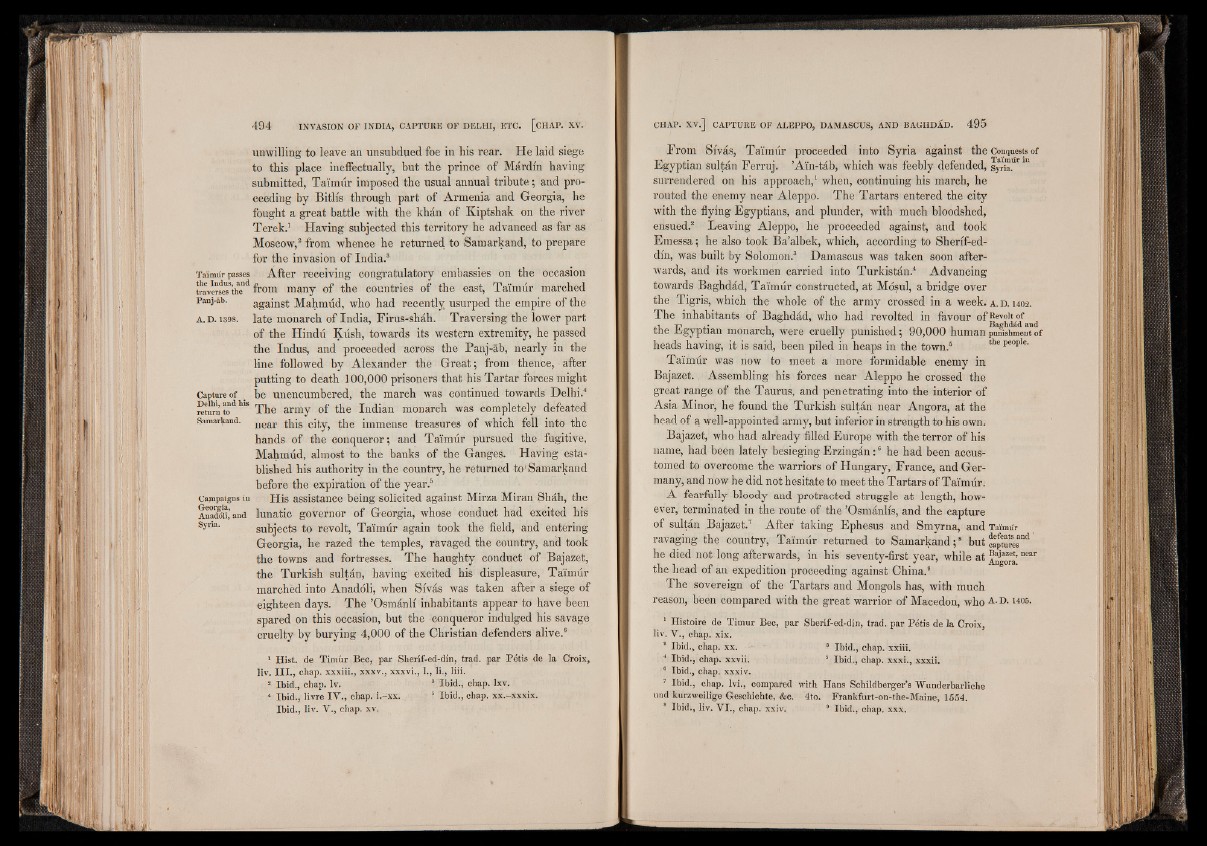
unwilling to leave an unsubdued foe in his rear. He laid siege
to this place ineffectually, but the prince of Márdín having
submitted, Taimúr imposed the usual annual tribute; and proceeding
by Bitlis through part of Armenia and Georgia, he
fought a great battle with the khan of Kiptshak on the river
Terek.1 Having subjected this territory he advanced as far as
Moscow,8 from whence he returned to Samarkand, to prepare
for the invasion of India.3
T a im* passes After receiving congratulatory embassies on the occasion
travireeTthed from many of the countries of the east, Taimúr marched
Panj-ab. against Mahmud, who had recently usurped the empire of the
a . d . 1398. late monarch of India, Firus-sháh. Traversing the lower part
of the Hindú Kúsh, towards its western extremity, he passed
the Indus, and proceeded across the Panj-ab, nearly in the
line followed by Alexander the Great; from thence, ■ after
putting to death 100,000 prisoners that his Tartar forces might
Capture of be unencumbered, the march was continued towards Delhi.4
return to ^ The army of the Indian monarch was completely defeated
Samarkand. near this city, the immense treasures of which fell into the
hands of the conqueror; and Taimúr pursued the fugitive,
Mahmúd, almost to the banks of the Ganges. Having established
his authority in the country, he returned to'Samarkand
before the expiration of the year.8
Campaigns in His assistance being solicited against Mirza Miran Sháh, the
Anadoii’ and lunatic governor of Georgia, whose conduct had excited his
Syria‘ subjects to revolt, Taimúr again took the field, and entering
Georgia, he razed the temples, ravaged the country, and took
the towns and fortresses. The haughty conduct of Bajazet,
the Turkish sultán, having excited his displeasure, Taimúr
marched into Anadoii, when Sívás was taken after a siege of
eighteen days. The ’Osmánlí inhabitants appear to have been
spared on this occasion, but the conqueror indulged his savage
cruelty by burying 4,000 of the Christian defenders alive.6
1 Hist, de Timur Bee, par Sherif-ed-din, trad, par Pétis de la Croix,
liv. I I I ., chap. xxxiii., xxxv., xxxvi., 1., li., iiii.
2 Ibid., chap. lv. 8 Ibid., chap. lxv.
4 Ibid., livre IV ., chap. i.-xx. ■> 1 Ibid., chap. xx.-xxxix.
Ibid., liv. V., chap. xv.
CHAP. XV.] CAPTURE OF ALEPPO, DAMASCUS, AND BAGHDÁD. 4 9 5
From Sívás, Taimúr proceeded into Syria against the Conquests of
Egyptian sultán Ferruj. ’Ain-táb, which was feebly defended, syria.U *
surrendered on his approach,1 when, continuing his march, he
routed the enemy near Aleppo. The Tartars entered the city
with the flying Egyptians, and plunder, with much bloodshed,
ensued.8 Leaving Aleppo, he proceeded against, and took
Emessa; he also took Ba’albek, which, according to Sherif-ed-
din, was built by Solomon.3 Damascus was taken soon afterwards,
and its workmen carried into Turkistán.4 Advancing
towards Baghdád, Taimúr constructed, at Mosul, a bridge over
the Tigris, which the whole of the army crossed in a week. a . D. 1402.
The inhabitants of Baghdád, who had revolted in favour o f Revoltof
the Egyptian monarch, were cruelly punished; 9 0 , 0 0 0 human pumshmeut'of
heads having, it is said, been piled in heaps in the town.5 the people'
Taimúr was now to meet a more formidable enemy in
Bajazet.. Assembling his forces near Aleppo he crossed the
great range of the Taurus, and penetrating into the interior of
Asia Minor, he found the Turkish sultán near Angora, at the
head of a well-appointed army, but inferior in strength to his own.
Bajazet, who had already filled Europe with the terror of his
name, had been lately besieging Erzingán:6 he had been accustomed
to overcome the warriors of Hungary, France, and Germany,
and now he did not hesitate to meet the Tartars of Taimúr.
A fearfully bloody and protracted struggle at length, however,
terminated in the route of the ’Osmánlís, and the capture
of sultán Bajazet.7 After taking Ephesus and Smyrna, and Taimúr
ravaging the country, Taimúr returned to Samarkand;8 b u t ^ ^ s “1
he died not long afterwards, in his seventy-first year, while at near
the head of an expedition proceeding against China.9
The sovereign of the Tartars and Mongols has, with much
reason, been compared with the great warrior of Macedón, who A-D- 1405-
1 Histoire de Timur Bee, par Sherif-ed-din, trad, par Petis de la Croix,
liv. V., chap. xix.
2 Ibid., chap. xx. 3 Ibid., chap. xxiii.
4 Ibid., chap. xxvii. 5 Ibid., chap. xxxi., xxxii.
s Ibid., chap. xxxiv.
1 Ibid., chap. lvi., compared with Hans Schildberger’s Wunderbariiche
und kurzweilige Geschichte, &c. 4to. Frankfurt-on-the-Maine, 1554.
8 Ibid., liv. V I., chap. xxiv. 3 Ibid., chap. xxx.